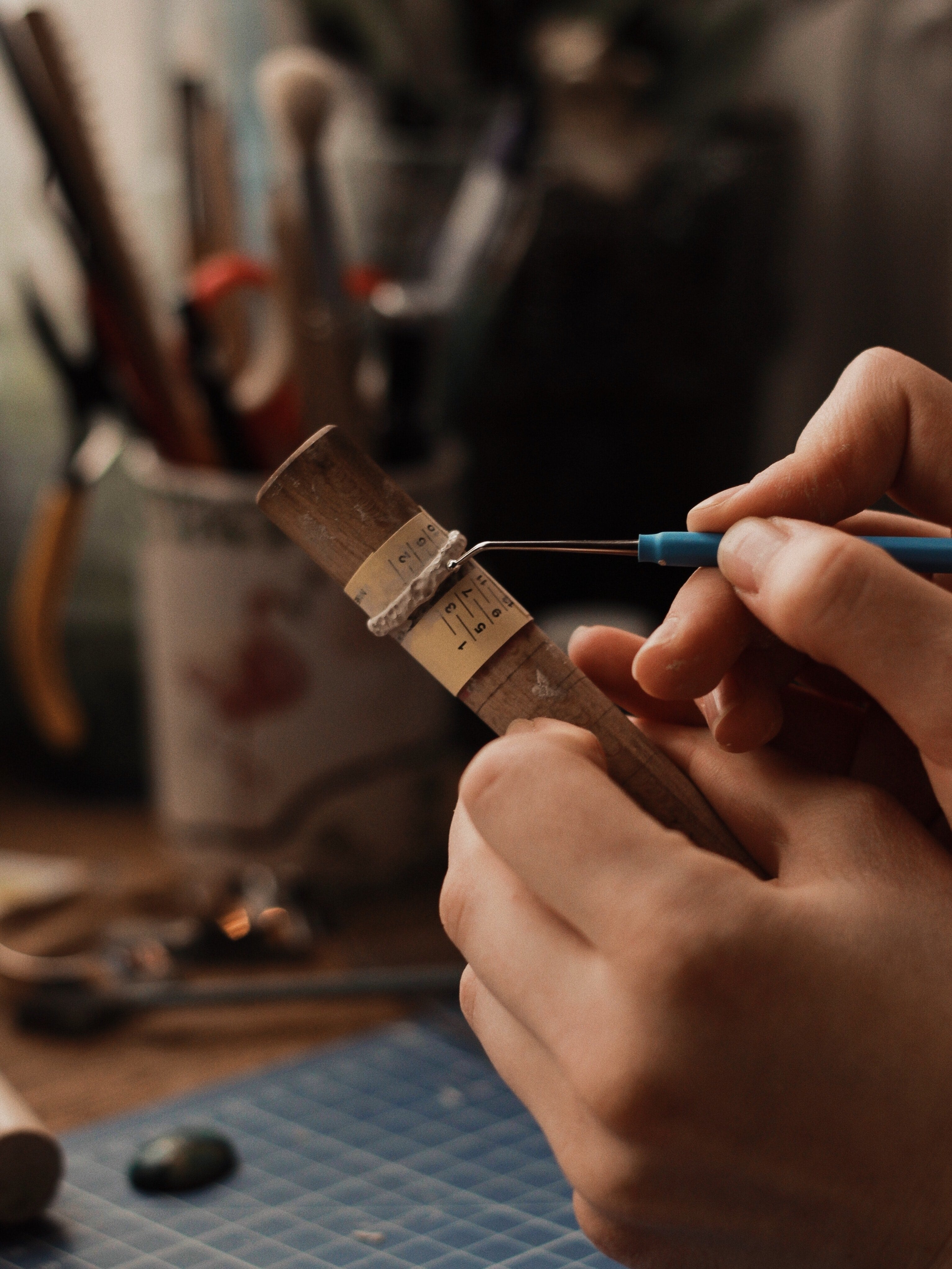Article: What constitutes well-designed jewelry?

What constitutes well-designed jewelry?
Standing surrounded by the gleam of dozens of diamonds in a jewelry store, what sets apart the piece you SHOULD buy from the pieces you SHOULDN’T buy?
Well-designed jewelry includes a combination of several key elements. Two of those elements are craftsmanship and the materials used.
First and foremost, craftsmanship! A beautiful design could be completely destroyed by poor craftsmanship, making good craftsmanship an essential pillar when it comes to well designed jewelry.
Craftsmanship is separated into more levels than simply good and bad. There are three levels to crafting jewelry.
- Completely bespoke forging
- Partial forging and partially cast
- Completely casting
Bespoke Forging
The very first piece of jewelry formed was made completely by hand. There was no mold to follow: Only the artist, their tools, and the materials. This is the most sought after form of craftsmanship. Every stroke against the metal have a meaning, and you know that every piece of your jewelry has been crafted with immense care.
Partial Forging
Casting has been brought into the jewelry industry as pieces were mass produced. Meaning that there are parts sitting on your finger that have a counterpart just like it on someone else’s finger. This is the second level because, while some parts are made in volumes and assembled together, there are specific pieces that are made just for you.
Casting
Most jewelry in the world are produced hundreds at a time. At most, pieces are cast as two parts to cut down on time and costs. This craftsmanship definitely leads to you getting your jewelry faster, but it does not result in anything NEAR the value that handmade pieces provide.
The care that is taken to craft a piece can be seen all over your piece: like in the state of the surface, shape, and polish. Good craftsmanship comes from a talented and experienced craftsman. The components of the jewelry, such as the clasps, settings, and chains, should be securely fastened and of good quality. The jewelry should be well-crafted and show attention to detail.
Some bad jewelry examples:

In the image above: The band is too thin. Thin bands are not suitable for everyday wear. Your band is supposed to get thicker if it has pave setting since pave setting creates holes on the band and therefore reduces its sturdiness.
In the image below: These are examples of poor craftsmanship. The basket is not adjusted right for the stone and the prongs are loose. This is a very scary scenario since you can lose your valuable gem.

Secondly, the materials used to make the jewelry should be of high quality, durable, and appropriate for the design. This can include precious metals, gemstones, and other materials that are resistant to wear and tear. In our philosophy, jewelry should last a lifetime, it should not tarnish and break. We believe in sustainability and sustainability comes with longevity. Instead of going in depth on the different metals and gemstones that should be a part of your piece, let’s look at why we choose those materials and the best examples for each quality:
- Color that doesn’t fade, tarnish, or oxidize
Metals
When choosing materials for your piece, one of the things you have to keep in mind is if you are going to have to constantly polish it to keep its look. One of the best and most popular examples of something that does NOT lose its color is platinum. Unlike gold, which requires to be consistently polished to hold onto that color.
Gemstones
Similar to platinum, diamonds will never fade. Diamonds do get dirty, which means that you still need to take good care of it. However, they will maintain their sparkle and represent endless love just like platinum. There are many gemstones, however, that will fade for different reasons. Emeralds, rubies, and sapphires tend to fade in direct light— which is why you do not find them as commonly when it comes to expressing the love that diamond engagement rings do.
- Rarity
Metals
Rarity is one of the prime elements that creates luxury and value. When you are looking for the perfect piece, the fact that it is worn by the majority undubitably takes away from it. Looking at rare metals, we go back to platinum. Platinum is incredibly rare— 30% more than gold. However, it is not enough just to say that there is platinum IN the ring. An important metric in rarity is purity. If the piece is less than 90% pure platinum, it is considered platinum alloy. You can find a stamp on the inside of the ring that says “PLAT” to show that it is a pure piece. The 2nd rarest metal is considered a platinum. You will not see the name “palladium” in a jewelry store, but it is technically more rare than platinum.
THE RAREST metal is rhodium. Rhodium can be found in the same ore that you find gold and silver, but significantly less. The earth produces approximately 30 tons of rhodium, in comparison to gold’s 3,000 tons. 100% more rare than gold.
Gemstones
The rarest gemstone is tanzanite. Found only in a small region of Northern Tanzania, discovered in 1967, with the blue variant being the most rare.
Other rare gemstones include: Benitoite, black opal, ammolite, kashmir sapphire, red beryl, and natural pearls.
- Strength and Durability
Metals
A gemstones strength is its ability to resist scratches and morphing. A gemstones durability is dictated by the metals capacity to resist wear and tear caused by heat, chemicals, humidity, and light.
The strongest metals include: Tungsten, ceramic, titanium, platinum, palladium, and cobalt
Gemstones
Diamonds are the hardest natural material in the world. However, it is fairly weak and brittle. Delicate, one would say. This is why diamonds are THE picture of elegance in fine jewelry.
Keeping an eye out for these different elements when it comes to the materials of your jewelry are crucial to distinguishing well-designed jewelry from that which is poorly designed. To conclude, we want to share the most important element to consider when buying jewelry.
Sustainability
Jewelry, by nature, are pieces of art created by precious minerals taken from the ground. However, the harm that mining for those precious metals is excruciatingly painful to mother earth and the people that live on it. Making decisions to buy pieces that make use of recycled metals or lab grown diamonds is key. While jewelry has the potential to create immense joy and communicate a beautiful love, it also has the potential to absolutely destroy communities and habitats. The thing that tips the scale one way or the other are your purchasing decisions— So continue to be mindful. Pursuing the best of life does not need to be a bloodstained endeavor.
















Leave a comment
This site is protected by hCaptcha and the hCaptcha Privacy Policy and Terms of Service apply.